For the second year in a row, the Hinge Research Institute’s annual High Growth Study showed that uncertainty is professional services firms’ overriding concern. Uncertainty overshadows the war for talent and worries about increased competition. Conflicts across the globe, mixed economic signals and political instability add smoke to a marketplace that’s undergoing change at breakneck speed.
Yet in spite of these challenges, overall growth rates improved over the prior year. And the best performers, which we call High Growth firms, accelerated their growth compared to their slower-growing counterparts. These high flyers grew 4X faster and enjoyed almost 2X the profits.
How did they do it? What do they do differently from other firms? Questions like these are what we designed this study to answer.
About the Study
This is the ninth edition of the High Growth Study. 824 firms across six professional services industry groups participated in this year’s research. The figure below shows the distribution of these industries in the sample.
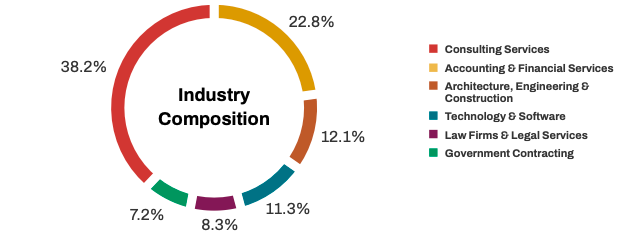
Participants represented firms of all sizes, and they conducted business in every region of the globe.
In the study, we grouped the participating firms into three categories: High Growth (see definition in the next section below), No Growth (those that experienced zero or negative growth), and Average Growth (the rest of the sample). Occasionally, you will encounter a group called Low Growth. This group includes both Average Growth and No Growth firms.
The High Growth Advantage
We define High Growth firms as those firms that achieve at least 20% compound annual growth over a three-year evaluation period. We compare these firms to those that experienced little or no growth over the same time frame. This allows us to identify strategies and practices that are associated with faster growth and higher profits.
This year’s High Growth cohort grew at an average rate of 41%—a significant jump over the previous year. By comparison, average Growth firms grew at 10% per year.
At the same time, High Growth firms are also more profitable than their slower-growing brethren. High Growth firms enjoyed an average profit of 25%—a slight improvement over the previous year’s number. However, all growth categories saw their profitability grow over the previous year. Even the group with negative growth, No Growth firms, achieved an average profit of almost 15%.

Five Key Pathways to Growth
Uncertainty has been a major cloud over the professional services industry for the past several years, and we don’t believe it is going away anytime soon. That means professional services firms need to adapt their marketing strategies to address a fickle, evolving marketplace. And there is no better place to look for inspiration than the High Growth firms that have thrived in it.
We’ve selected five key findings from the study that firms like yours can use to compare against your own marketing strategy as you drive toward sustained growth.
1. HIGH GROWTH FIRMS USE MARKETING TO SUPPORT CLOSING THE SALE
Unlike past years, when digital techniques dominated this list, today’s High Growth firms are getting the most bang by using marketing to support sales-oriented, bottom-of-the-funnel activities. In the chart below, you’ll see that the top three most impactful techniques identified by High Growth firms were 1) assessments and consultations, 2) live demos, and 3) business development materials, such as qualifications presentations, pitch materials, and proposals.
Why the change? We’ve noticed that over the past three years, High Growth firms have invested more than their slower growing competitors in digital marketing techniques and digital infrastructure such as CRM, AI, and marketing automation. We think this early investment is now paying dividends. Many tasks that once were manual—or weren’t done at all—are now automated and efficient. As a result, it’s faster and easier to close new business.
Don’t lose sight of #5. High Growth firms have been a perennial leader when it comes to conducting formal research on their target audience. We believe this is an important way they are able to see past any uncertainty and make better informed, more confident decisions.
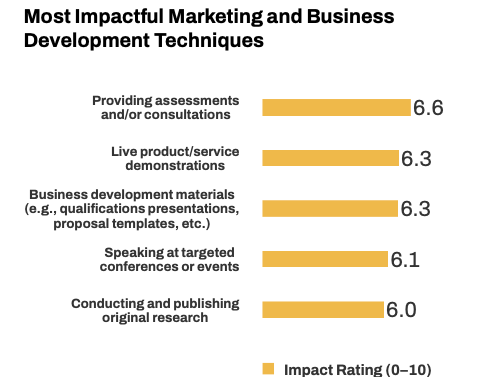
2. HIGH GROWTH FIRMS PRIORITIZE CONTENT MARKETING
Producing high-quality content is High Growth firms’ top marketing priority in 2024. Why? Today’s buyer journey often begins long before a company is ready to find a service provider. They are researching answers to their organization’s problems very early in process—often months or years before they are ready to buy. Educational content such as blog posts, executive guides, white paper and ebooks address this need. And when content is optimized for online search, it makes a firm’s expertise accessible to a much wider audience. If a firm can produce valuable content on a regular basis they build a loyal following—people who, when they are ready to buy, think first of the firm that has demonstrated a deep understanding of their issues.
Differentiation, in second place, is a top priority for very good reason. Firms that can stand apart from their competitors tend to be perceived as more valuable. They are also more unique and memorable. This means it’s easier to close business—and command premium fees. What’s not to like about that?
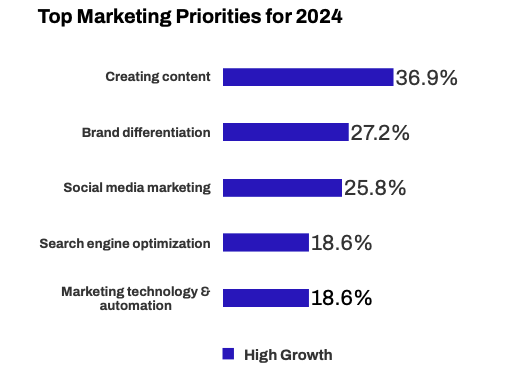
3. HIGH GROWTH FIRMS SPEND MORE ON MARKETING
While marketing budgets across the professional services declined for the second year in a row, High Growth firms’ spend held steady at 10% of revenue. Where slower growing firms may be holding on to their cash in the face of continued market uncertainty, the High Growth contingent is plowing ahead—and reaping the rewards.

4. TOP PERFORMING FIRMS OUTSOURCE SPECIALIZED MARKETING SKILLS MORE OFTEN
Across the board, the High Growth cohort in our study was more likely than No Growth firms to outsource specialized marketing skills. These firms either don’t have the skills in-house or they are looking to specialists to drive better performance. These firms also know that their performance advantage is based at least in part on their ability to build a consistent, highly credible brand and generate more new business more quickly than their competitors. Outsourcing this expertise gives firms access to the best talent and technology without bulking up their overhead.
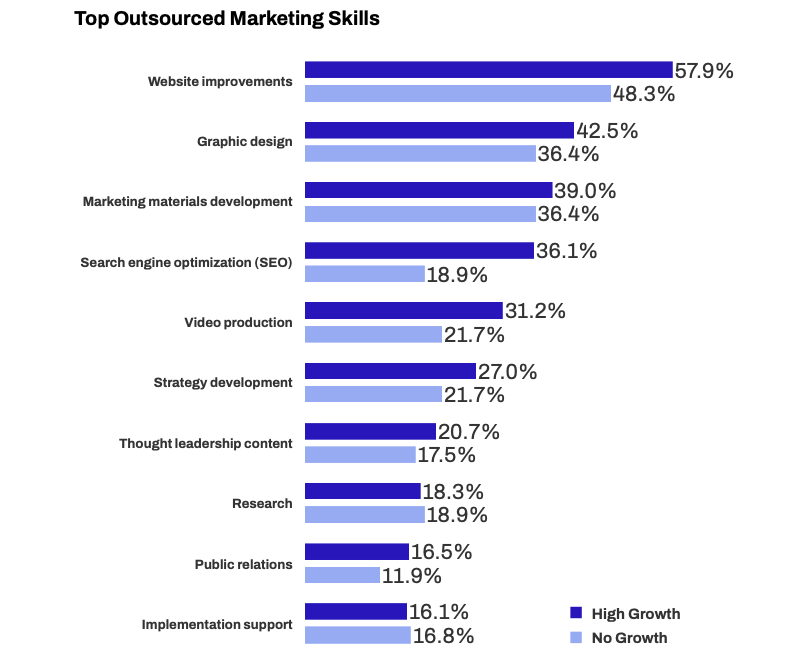
5. WHERE DO HIGH GROWTH FIRMS TURN FIRST FOR RECRUITING? LINKEDIN
High Growth firms are able to attract more skilled talent than their slower-growing competitors. In part, this may be due to factors such as differentiation, culture and the allure of working in a fast-growing business. But that’s not the whole story. They also recruit differently. The chart below shows which channels High Growth firms use to recruit future employees compared to their No Growth brethren.
LinkedIn is their top recruiting tool, which High Growth firms use 33% more often. In second place are social media posts, which they employ 25% more frequently. Notably, the High Growth group uses every technique more often than their No Growth peers. Clearly, recruiting is something they take very seriously.
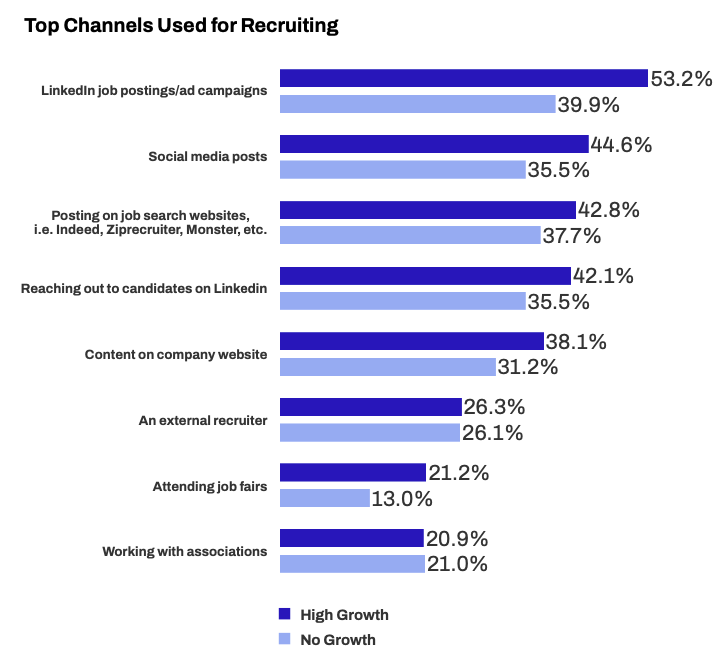
What’s Your Strategy to Thrive in Uncertain Times?
Uncertainty is going to be with us for a while. This means today’s firms need to adapt to a shifting, murkier environment. When the old marketing tools no longer cut through the fog, you need new strategies and techniques to help you see a little further ahead and avoid the obstacles in your way.
Fortunately, High Growth professional services firms have already blazed a trail for firms like yours. They have learned what works and what is a waste of time in an age of unpredictability and rapid change. So what can you do? Compare the habits of High Growth firms in this post with your own marketing program. Where are you in alignment and where are you off the rails? What adjustments can you make to emulate these high performers? There is a blueprint here to sustained business success—if you choose to follow it.

